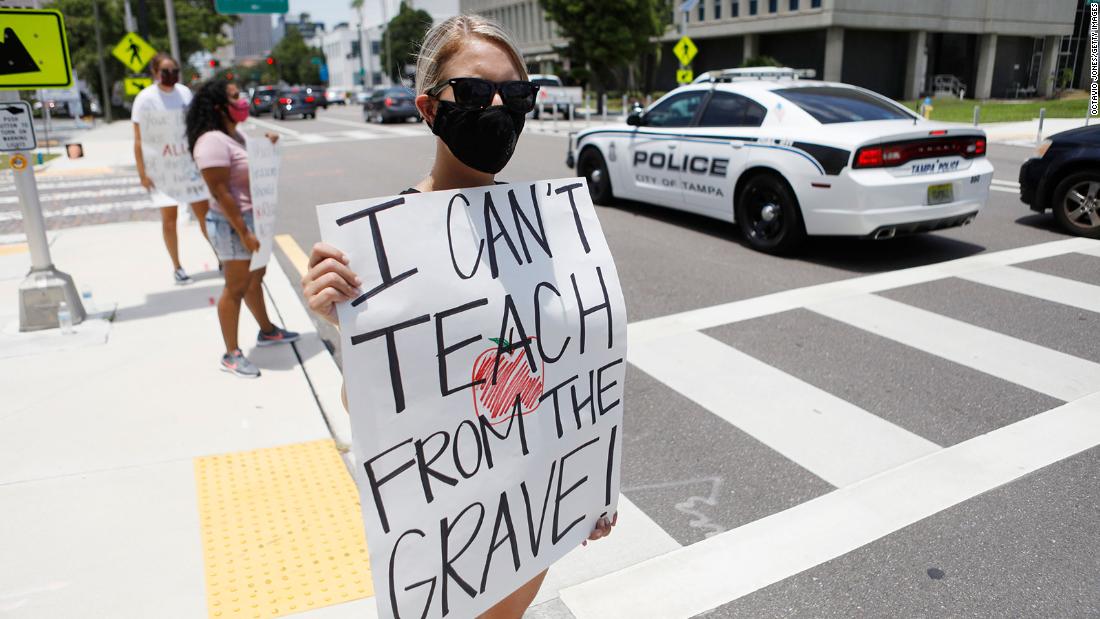Analysis: Face it. Most kids are not going to school next month
What this will look like. There will be some who fight their way onto private school lists. There will be people who threaten to move to another town (for all the good that does them). There will be a lot of kids who are left out of whatever supplemental plans parents cook up. The bottom line is most people will need to buckle in for more distance learning, alongside their own work and other responsibilities.
The President is still 100% for schools opening, even as school officials run the other way. President Donald Trump didn’t mention his recent demand that US schools open this fall, Covid-be-damned, at his first briefing on the coronavirus since April. But he said Wednesday that he “would like to see the schools open 100%” — and then immediately pivoted to the economy, which is why he wants schools to reopen.
Kids and families will pay a price for the early reopening. But it’s the crisis of American education, more than anything, that illustrates how the country squandered the wins from months of self-imposed quarantine this spring in exchange for a summer of ignoring the obvious.
New Covid surge = online-only schools this fall
Together those comprise a major chunk of the DC suburbs. Kids in the nation’s capital won’t know until July 31 if the city will offer any kind of in-person education this fall or whether it will be online.
It shows five of the nation’s 10 largest districts will be distance learning this fall, which begins next month for most kids.
Or not. Some districts don’t have a start date. Others are delaying into September. New York City’s mayor has pledged to implement a hybrid model, but details are still in flux and the state’s governor must sign off. He won’t do that until August.
The writing is on the wall
And the superintendent there, Alberto Carvalho, told CNN’s John King on Wednesday that the current situation in the county would not allow for in-person instruction.
“The conditions are not currently appropriate for us to be able to teach kids while at the same time safeguard their well-being,” he said, adding the district wants to make a final decision by the first week of August on whether students will return on August 24.
And those districts that are promising in-person instruction are banking on a large portion of students staying home anyway. Otherwise, they’re not likely to have enough teachers. That’s what happened in Fairfax County, according to the Washington Post, and other places, where district leaders feared they wouldn’t have enough teachers to pull off even a hybrid, part-time in-person schedule, like some other districts are hoping to pursue.
This crisis also further isolates the US from other developed countries, which leaned harder into face masks and social distancing and who are now sending their children physically back to schools.
We should not miss a national opportunity
We haven’t even gotten into the problem of inequality.
There will be parents hiring tutors and gathering to do their own schooling, which could leave students who don’t have access to those perks — or in some cases even access to the internet — behind. Those are problems that predate the pandemic, but will be made worse by it.
CNN called Reville to ask him about the current moment, which seems like total chaos. Here’s what he said:
Reville: Right now I’d say you know a number of our districts are still an emergency response mode. They’re kind of like a traumatized patient in the emergency room. They can’t really change their lifestyle until they get up and functioning as a healthy sort of entity in the first place.
But he said some districts are already faring better than others, and that will only exacerbate an achievement gap.
Reville: In some school systems that’s gonna be just fine because they’re prepared to go online. They either have prior experience or they are small enough that they’ve been able to be nimble and move quickly to make decisions and build capacity over the summer.
Other places are just struggling to get the basic pre-requisites in place to get the internet access to everybody, to make system-wide decisions on platforms and applications, what curricula to be used.
In a lot of our bigger school districts I think are still struggling with that. It’s a very messy situation. And many of them didn’t do very well in the fourth quarter of this past academic year, so now you’re gonna have students coming coming back to school with uh wider and wider gaps in terms of their readiness to do the next grade level.
Education will be forever changed by this, he said, when CNN asked if we’ve missed a valuable moment to rethink how we educate our kids.
Reville: No, that opportunity still exists. We are not returning to the status quo ante. The field will show permanent changes as a result of this crisis and our adaptations to it. However, in the present, we’re like a community still reeling from an earthquake, emerging from the rubble, trying to get basic systems back in place before we can consider more transformative changes. There is no doubt, though, that because of this experience parents, students and teachers will be seeking profound changes in the way education operates in the future.
![]()


